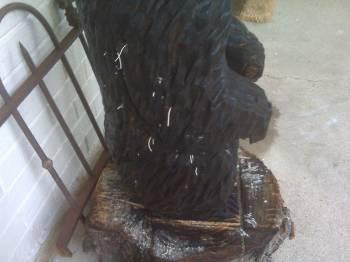Economics of End-Coating to Prevent Checking
If you look at the numbers, sealing log or board ends is worth the cost. June 13, 2014
Question
Is it necessary to end wax green 4/4 lumber, particularly hard and soft maple through the winter months with temperatures below 50 degrees, although the lumber will be dried in a kiln?
Forum Responses
(Commercial Kiln Drying Forum)
From Contributor M:
If the lumber is primarily Sel and Btr or FAS grade and especially if there is a lot of wide stock, I would recommend the end coat. Small cracks and end checks that develop in the air drying yard have the potential to run into major splits when put in a planer after kiln drying. The hard maple is more valuable than the soft if you can only do part of it.
From Gene Wengert, forum technical advisor:
It is well to remember that 1" of end check on an 8' piece of lumber is 1% loss when that 1" is cut off at the manufacturing plant. Of course, if they do not get all of the end check when they cut (trying to improve yield), then they will have a defect in the final product that can cost a lot of money to repair. So, from this perspective, end coating in the wintertime (because wood does check then, even in air drying) is well worth the quality improvement for the customer. Unfortunately, they may not realize it and be unwilling to pay $3 per MBF more. Anchorseal does come in a no-freeze formulation. Just make sure you put it on thick enough. Avoid over-spray as much as possible. The benefit for an expensive species like hard maple, cherry, oak, etc. is high, so even 4/4 is worth coating. It is less obvious for less costly species in the wintertime, but having your operation known for quality in all species of lumber by customers is certainly worth something.
From contributor H:
I would think an end coating like Anchorseal might cause problems during kiln drying? What is the thinking on this? Most reputable sawmills cut over length lumber and most of the time as much as four inches.
From Gene Wengert, forum technical advisor:
What sort of problems? Anchorseal and a few other products are used every day to prevent end checks and there is no issue when kiln drying. Note that Anchorseal does melt at 130 F. Some products stay on at even higher temperatures.
From Gene Wengert, forum technical advisor:
Incidentally, cutting lumber 4" too long is 4% for 8' lumber. At $500 per MBF, that would be $20 or $5 per inch. As Anchorseal is only $3 per MBF, it would seem clear that Anchorseal is a better choice than cutting longer lumber and then trimming after drying. With 4" extra (that is 2" on each end) many times end checks will be longer than 2", so the extra length will not be adequate to eliminate end checks. Anchorseal, applied heavy enough and as soon as possible, is nearly 100% effective.
Note also that if logs are 4" shorter, then the next log up the tree will be just a bit larger in diameter. This will also increase lumber yield. The bottom line is that end coating is financially and environmentally a good practice. (Of course, using Anchorseal and also cutting 4" longer is not a good idea.)
From contributor B:
Our company has taken a hard stance on requiring end waxing, to the tune of rejecting loads if not end waxed, although in a tight lumber market every load is important to fill demand. If I can't buy enough green lumber I have to buy custom dried at a 50% plus premium price over green. Are there any studies or gut feels of the yield loss on maple unwaxed vs waxed? My thought is we should never turn a truck away if there is a chance we would have to replace with a custom KD load because of the significant premium on custom KD loads.
From Gene Wengert, forum technical advisor:
You might consider the approach of reducing the price of any uncoated lumber by $10 per MBF. Make sure that you coat it ASAP after you get it. Your company should also look at the coating for the quality. End coatings must be thorough and applied thick enough. If you have a good customer that does not end coat, maybe you could buy the end coating for him and then see if he would apply it correctly just for you. The lumber market is only tight at the price you are paying. Increasing the price you pay will provide more lumber, or increase the distance that you will go for wood and give them a transportation allowance.
